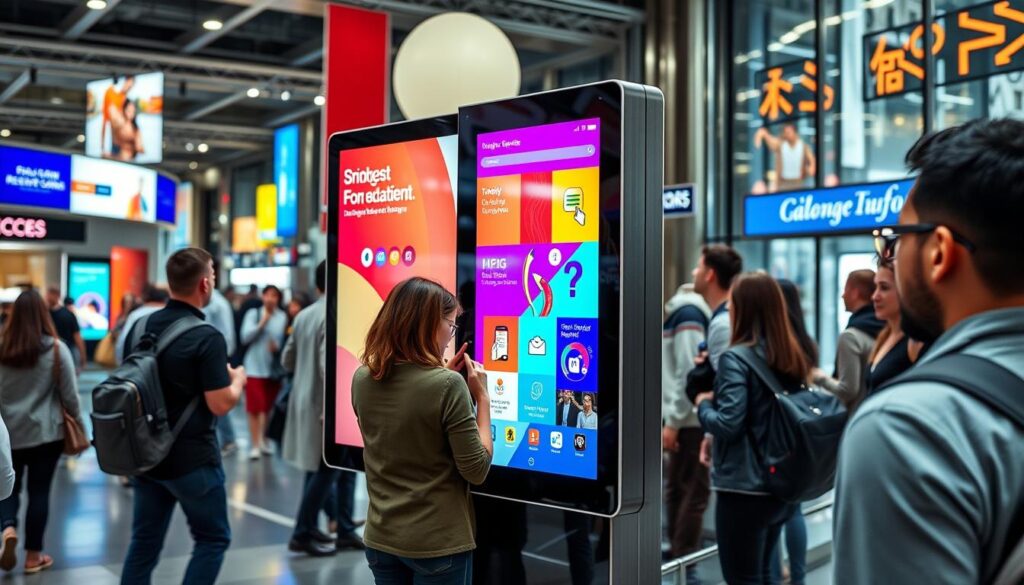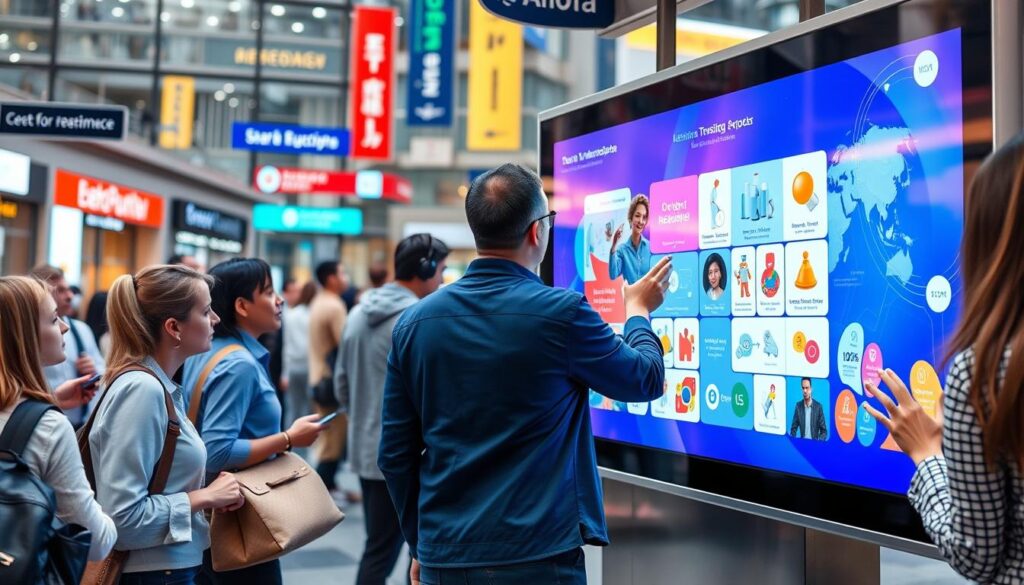Touch screen digital signage software is a big step forward in marketing and communication. It lets businesses share interactive and dynamic content on digital screens. This software uses advanced tech like LCD, LED, and projection to show offers and important info better than old methods.
It moves from just watching to engaging with the content. This makes digital signage more important in today’s quick world. It’s now key for businesses to connect with their audience.
Reports say the digital signage market will grow by about 8% by 2030. Companies using this software see more money, better communication, and happier customers and workers. For example, Samsung’s digital signage hardware can cut costs by up to 25% for big installations.
Touchscreens are everywhere now, and digital signage is really showing its worth. It helps with *real-time engagement*, making a stronger bond with people. We’ll look at what makes good touch screen digital signage software and how it can help your business.

Key Takeaways
- The digital signage market is projected to grow by around 8% by 2030.
- Touch screen digital signage software enhances customer engagement and communication.
- Companies utilizing digital signage solutions report improved satisfaction and revenue.
- Samsung’s hardware integrates a built-in player for significant budget savings.
- Interactive touchscreen displays facilitate real-time user engagement.
- Digital signage can attract 400% more views than static signage.
- Crafting effective digital signage content requires clear objectives and audience understanding.
2. Key Features of Touch Screen Digital Signage Software
Touch screen digital signage software is changing how businesses talk to their audience. It has key features that make it better for users and content. Good touch screen software for ads boosts customer interest and makes managing content easier. Here are the main parts that make great interactive touch screen software.
Design Tools and Templates
Today’s digital signage platforms have many design tools and templates. These tools help users make content that looks good fast. Businesses can make professional-looking designs without needing to be graphic designers. This keeps the content interesting and right for their audience.
Multimedia Support (images, videos, animations)
Good touch screen digital signage software supports many types of media, like images, videos, and animations. This lets users add rich media that grabs attention and shares brand messages well. Rich media makes the experience more engaging and shows the dynamic side of digital signage.
Interactive Elements (touch-activated buttons, menus, games)
Interactive elements like touch-activated buttons, menus, and games make viewing active. This keeps people interested and involved with the content. Adding these features makes the digital signage platform more effective.
Gesture Support (tap, swipe, pinch, zoom)
Gestures like tap, swipe, pinch, and zoom are key in touch screen software for ads. They let users move through content easily. This makes using digital displays smooth and fun.
3. Applications of Touch Screen Digital Signage
Touch screen digital signage changes many industries by making things more interactive and engaging. It has many uses that help both customers and businesses. It’s great for showing off products and making it easier to find your way around.
Interactive Product Catalogs
Interactive product catalogs let customers look at products easily on touch screens. They can see detailed pictures and descriptions. This makes customers happier because they can look without feeling rushed.
Wayfinding and Store Directories
Touch screens make it easier to find your way in big places like malls and airports. They give clear directions and info. This makes shopping or traveling easier and less confusing.
Promotional Displays and Offers
Promotional displays on touch screens show off special deals and offers. They grab attention and make people want to check them out. This can lead to more sales for businesses.
Employee Communication and Training
In offices, touch screens are great for talking to employees. They can show training videos and updates. This keeps everyone informed and helps work go smoothly.
| Application | Benefits | Industries |
|---|---|---|
| Interactive Product Catalogs | Enhances customer engagement and satisfaction | Retail, E-commerce |
| Wayfinding | Improves navigation and ease of access | Malls, Airports, Large Venues |
| Promotional Displays | Increases visibility of offers and discounts | Retail, Restaurants |
| Employee Communication | Facilitates training and information sharing | Corporate Settings |
4. Choosing the Right Touch Screen Digital Signage Software
Choosing the right touch screen digital signage software is key. You need to know your business goals and what your audience likes. The best software will meet your needs and make things interactive for your customers.
Business Objectives and Target Audience
First, think about what you want to achieve. Knowing who you’re trying to reach helps you make content they’ll like. This way, you can pick software that fits your goals and what your audience wants.
Hardware Requirements and Compatibility
Before you start, figure out what hardware you need. Different screens have different specs, like size and how well they work. For example, a 55-inch screen can cost a lot, depending on the brand and use.
OnSign TV is great because it works with many operating systems. This makes it easy to find a screen that fits your needs.
Software Features and Customization Options
Look at what software features you need. Things like gesture support and easy-to-use interfaces make your signs more interactive. Yodeck shows how software can make a big difference in how people interact with your signs.
Budget and Scalability
Know how much you can spend. This helps you choose between screens made for businesses or for home use. Also, think about how your business might grow. Choose software that can grow with you, so you don’t have to change everything later.

| Consideration | Details |
|---|---|
| Screen Size | 32-43 inches for small settings; 50-65 inches or larger for spacious areas. |
| Operating Capacity | 16/7 and 24/7 options available for various usage needs. |
| Durability | Outdoor screens should be robust, bright, and temperature resistant. |
| Average Prices | Commercial screens typically $800-$2500; consumer screens $400-$1500. |
5. Top Touch Screen Digital Signage Software Providers
Many providers lead in the touch screen digital signage software field. They offer special features for different business needs. It’s key to know what each offers to pick the best for your ads.
Leading Providers Overview
Here’s a detailed comparison of some of the top providers in the industry:
| Provider | Key Features | Monthly Cost | User Reviews |
|---|---|---|---|
| BrightSign | Innovative solutions for businesses, remote player monitoring | Varies | 4.5 stars on SourceForge |
| Cayin Technology | Reliable solutions, cloud-based content management via GO CAYIN | Varies | 4 stars on average across platforms |
| friendlyway | User-friendly cloud software, deployed on 25,000 devices | Varies | 4.4 stars on average |
| Mandoe Media | AI-powered content generation, access to Shutterstock | Varies | 4.5 stars on user feedback |
| Omnivex | Simplifies management for mid to large companies, versatile applications | Varies | 4.6 stars overall |
| Wallboard | Extensive template library, customizable widgets | Plans start at $8.99 | 4.8 stars on Capterra |
| Yodeck | Affordable options with a free plan for single screen usage | Starts at $8.99, free plan available | 4.5 stars on multiple review sites |
Choosing the right digital signage software is key for better ads. Each provider has unique benefits. From lots of templates to easy remote management, they help businesses meet their goals.

6. Designing Effective Touch Screen Digital Signage Content
Making great content for touch screen digital signs needs smart design rules. It’s all about how people use the content. Designers aim to make it fun and easy to use with special software.
Usability Principles for Touchscreens
For digital signs that people touch, making it easy to use is key. Important rules include:
- Navigation that’s simple and easy to use.
- Feedback that shows when you’ve done something, making it more fun.
- Content that everyone can use, following ADA rules.
Visual Design and Layout
How things look affects how people pay attention and understand. Good design means:
- Fonts that are big enough to see from far away, 20-30 points.
- Keeping text short and simple, with no more than three lines or five words per line.
- Putting pictures on the left side to make it easier to follow.
Content Optimization for Touch Interaction
Designing content for touch screens can really get people involved. This includes:
- Using interactive features like touch screens and QR codes.
- Adding augmented reality to make choices more fun.
- Using Google Analytics to see how people interact and improve the content.
Accessibility Considerations
Designing for everyone means making sure it’s accessible. Good ways to do this include:
- Choosing colors that are easy to see for people with vision problems.
- Adding audio descriptions for those who can’t see well.
- Using clear layouts to help people understand and follow.
| Common Design Mistakes | Solutions |
|---|---|
| Cluttered Screens | Keep it simple with clear messages. |
| Poor Contrast | Use colors that are easy to see. |
| Too many moving parts | Use fewer animations and focus on clear images. |
| No Hierarchy | Make a clear order to help viewers follow. |
Good design makes using digital signs better. It helps content reach and connect with more people, thanks to special software.
7. Deploying and Managing Touch Screen Digital Signage
Setting up touch screen digital signage needs careful thought about hardware and where to put it. The right display depends on where it will be used, indoors or outdoors. Think about power needs, how to connect it, and where to place it for the best view and user interaction.
Hardware Selection and Installation
Businesses should use tools like Samsung Remote Management Cloud for better digital signage. This lets you watch your displays from anywhere, cutting down on service visits. Samsung MagicINFO™ also helps with security and updating content quickly, making management easier.
Using systems like MagicINFO™ Insight helps control many displays at once and shows how well they’re doing. This makes managing your digital signs more efficient. It also makes sure your displays look great and work well, improving customer experience and business results.
FAQ
What is touch screen digital signage software?
Touch screen digital signage software is a modern platform. It shows interactive and dynamic content on digital displays. It uses LCD, LED, and projection to grab customers’ attention.
What are the key features of interactive digital signage software?
Key features include design tools and templates for easy content creation. It supports multimedia like images, videos, and animations. It also has interactive elements like touch-activated buttons and games.
It even supports gestures like tap, swipe, pinch, and zoom.
How can businesses utilize touch screen kiosks?
Businesses can use touch screen kiosks in many ways. They can show interactive product catalogs and store directories. They can also use them for promotional displays and employee training.
What factors should be considered when choosing touch screen digital signage software?
When choosing, consider your business goals and who you’re targeting. Think about the hardware and software needs. Also, consider your budget and if you can grow with the software.
Which providers are the top choices for touch screen digital signage software?
Top providers include Samsung’s MagicINFO, BrightSign, Scala, and Rise Vision. Each offers unique features to meet different business needs.
How do I design effective content for touch screen digital signage?
Designing effective content means following usability principles. Focus on easy navigation and clean design. Make sure content works well with touch and is accessible to everyone.
What steps are involved in deploying and managing touch screen digital signage?
Deploying involves choosing the right hardware and installing it. Consider where it will be and power needs. Managing means updating content and scheduling to keep it engaging.